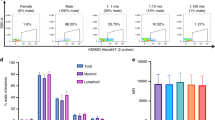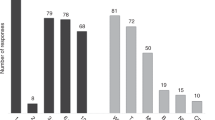Summary:
Allogeneic bone marrow transplantation (BMT) with marrow ablative conditioning is the treatment of choice for haematopoietic malignancies. The use of nonmyeloablative stem cell transplants has allowed the treatment of patients previously ineligible for BMT because of age or other disease. These reduced conditioning regimes allow the persistence initially of some recipient cells in the blood and bone marrow (haematopoietic chimaerism). Monitoring of the relative proportion of donor and recipient cells is required to assess the success of the procedure, to predict subsequent rejection or impending relapse and to guide the use of donor lymphocyte infusions. We present a quantitative real-time PCR approach for the measurement of haematopoietic chimaerism using the TaqMan™. This approach exploits the presence of single-nucleotide polymorphisms (SNPs) to distinguish cells of patient or donor origin. We have designed and validated a panel of seven allele-specific probes to quantify the contribution of patient and donor cells in the haematopoietic population from 12 patient and donor pairs. We have compared the performance of this approach with an existing method and proved it to be superior in both accuracy and sensitivity. The use of more sensitive and accurate techniques permits earlier intervention for improved clinical outcome.
This is a preview of subscription content, access via your institution
Access options
Subscribe to this journal
Receive 12 print issues and online access
$259.00 per year
only $21.58 per issue
Buy this article
- Purchase on Springer Link
- Instant access to full article PDF
Prices may be subject to local taxes which are calculated during checkout



Similar content being viewed by others
References
Bensinger WI, Buckner CD, Anasetti C et al. Allogeneic marrow transplantation for multiple myeloma: an analysis of risk factors on outcome. Blood 1996; 88: 2787–2793.
Weiden PL, Flournoy N, Thomas ED et al. Antileukemic effect of graft-versus-host disease in human recipients of allogeneic-marrow grafts. N Engl J Med 1979; 300: 1068–1073.
Carella AM, Lerma E, Corsetti MT et al. Evidence of cytogenetic and molecular remission by allogeneic cells after immunosuppressive therapy alone. Br J Haematol 1998; 103: 565–567.
Carella AM, Champlin R, Slavin S et al. Mini-allografts: ongoing trials in humans. Bone Marrow Transplant 2000; 25: 345–350.
Mackinnon S, Barnett L, Heller G, O'Reilly RJ . Minimal residual disease is more common in patients who have mixed T-cell chimerism after bone marrow transplantation for chronic myelogenous leukemia. Blood 1994; 83: 3409–3416.
Serrano J, Roman J, Herrera C et al. Increasing mixed haematopoietic chimaerism after BMT with total depletion of CD4+ and partial depletion of CD8+ lymphocytes is associated with a higher incidence of relapse. Bone Marrow Transplant 1999; 23: 475–482.
Mattsson J, Uzunel M, Brune M et al. Mixed chimaerism is common at the time of acute graft-versus-host disease and disease response in patients receiving non-myeloablative conditioning and allogeneic stem cell transplantation. Br J Haematol 2001; 115: 935–944.
Nakao S, Nakatsumi T, Chuhjo T et al. Analysis of late graft failure after allogeneic bone marrow transplantation: detection of residual host cells using amplification of variable number of tandem repeats loci. Bone Marrow Transplant 1992; 9: 107–111.
Gardiner N, Lawler M, O'Riordan J et al. Persistent donor chimaerism is consistent with disease-free survival following BMT for chronic myeloid leukaemia. Bone Marrow Transplant 1997; 20: 235–241.
Khan F, Agarwal A, Agrawal S . Significance of chimerism in hematopoietic stem cell transplantation: new variations on an old theme. Bone Marrow Transplant 2004; 34: 1–12.
Thiede C . Diagnostic chimerism analysis after allogeneic stem cell transplantation: new methods and markers. Am J Pharmacogenomics 2004; 4: 177–187.
Blazar BR, Orr HT, Arthur DC et al. Restriction fragment length polymorphisms as markers of engraftment in allogeneic marrow transplantation. Blood 1985; 66: 1436–1444.
Scharf SJ, Smith AG, Hansen JA et al. Quantitative determination of bone marrow transplant engraftment using fluorescent polymerase chain reaction primers for human identity markers. Blood 1995; 85: 1954–1963.
Lareu M, Puente J, Sobrino B et al. The use of the LightCycler for the detection of Y chromosome SNPs. Foren Sci Int 2001; 118: 163–168.
Leclair B, Fregeau CJ, Aye MT, Fourney RM . DNA typing for bone marrow engraftment follow-up after allogeneic transplant: a comparative study of current technologies. Bone Marrow Transplant 1995; 16: 43–55.
Lawler M, Humphries P, McCann SR . Evaluation of mixed chimerism by in vitro amplification of dinucleotide repeat sequences using the polymerase chain reaction. Blood 1991; 77: 2504–2514.
Lion T, Muller-Berat N . Chimerism testing after allogeneic stem cell transplantation: importance of timing and optimal technique for testing in different clinical–biological situations. Leukemia 2003; 17: 612.
Lion T . Summary: reports on quantitative analysis of chimerism after allogeneic stem cell transplantation by PCR amplification of microsatellite markers and capillary electrophoresis with fluorescence detection. Leukemia 2003; 17: 252–254.
Hancock JP, Goulden NJ, Oakhill A, Steward CG . Quantitative analysis of chimerism after allogeneic bone marrow transplantation using immunomagnetic selection and fluorescent microsatellite PCR. Leukemia 2003; 17: 247–251.
Brookes AJ . The essence of SNPs. Gene 1999; 234: 177–186.
Fredriksson M, Barbany G, Liljedahl U et al. Assessing hematopoietic chimerism after allogeneic stem cell transplantation by multiplexed SNP genotyping using microarrays and quantitative analysis of SNP alleles. Leukemia 2004; 18: 255–266.
Hochberg EP, Miklos DB, Neuberg D et al. A novel rapid single nucleotide polymorphism (SNP)-based method for assessment of hematopoietic chimerism after allogeneic stem cell transplantation. Blood 2003; 101: 363–369.
Heid CA, Stevens J, Livak KJ, Williams PM . Real time quantitative PCR. Genome Res 1996; 6: 986–994.
Oliver DH, Thompson RE, Griffin CA, Eshleman JR . Use of single nucleotide polymorphisms (SNP) and real-time polymerase chain reaction for bone marrow engraftment analysis. J Mol Diagn 2000; 2: 202–208.
Alizadeh M, Bernard M, Danic B et al. Quantitative assessment of hematopoietic chimerism after bone marrow transplantation by real-time quantitative polymerase chain reaction. Blood 2002; 99: 4618–4625.
Maas F, Schaap N, Kolen S et al. Quantification of donor and recipient hemopoietic cells by real-time PCR of single nucleotide polymorphisms. Leukemia 2003; 17: 630–633.
Wickham C, Joyner M, Lynas C, Ellard S . Detection of clonal B-cell populations using fluorescently labelled nucleotides. Biotechniques 2000a; 29: 215–218.
Sherry ST, Ward MH, Kholodov M et al. dbSNP: the NCBI database of genetic variation. Nucleic Acids Res 2001; 29: 308–311.
Kaisaki PJ, Menzel S, Lindner T et al. Mutations in the hepatocyte nuclear factor-1alpha gene in MODY and early-onset NIDDM: evidence for a mutational hotspot in exon 4. Diabetes 1997; 46: 528–535.
Socie G, Cayuela JM, Raynal B et al. Influence of CD34 cell selection on the incidence of mixed chimaerism and minimal residual disease after allogeneic unrelated donor transplantation. Leukemia 1998; 12: 1440–1446.
Amabile M, Giannini B, Testoni N et al. Real-time quantification of different types of bcr-abl transcript in chronic myeloid leukemia. Haematologica 2001; 86: 252–259.
Bolufer P, Sanz GF, Barragan E et al. Rapid quantitative detection of BCR-ABL transcripts in chronic myeloid leukemia patients by real-time reverse transcriptase polymerase-chain reaction using fluorescently labeled probes. Haematologica 2000; 85: 1248–1254.
Acknowledgements
This work was funded by a small research grant from the Royal Devon and Exeter NHS Foundation Trust R&D Directorate. We thank the Exeter Leukaemia Fund for funding the purchase of additional probes. We thank Dr Richard Lee, Dr Marilyn Pocock and Dr Claudius Rudin at the Royal Devon and Exeter NHS Foundation Trust for providing samples and valuable advice; Dr Tim Frayling from the Peninsula Medical School for designing the T515 primers and probes and Mr Neil Goodman for carrying out the artificial mixing experiments.
Author information
Authors and Affiliations
Corresponding author
Rights and permissions
About this article
Cite this article
Harries, L., Wickham, C., Evans, J. et al. Analysis of haematopoietic chimaerism by quantitative real-time polymerase chain reaction. Bone Marrow Transplant 35, 283–290 (2005). https://doi.org/10.1038/sj.bmt.1704764
Received:
Accepted:
Published:
Issue Date:
DOI: https://doi.org/10.1038/sj.bmt.1704764
Keywords
This article is cited by
-
Alterations in LMTK2, MSMB and HNF1B gene expression are associated with the development of prostate cancer
BMC Cancer (2010)
-
A family with a novel TSH receptor activating germline mutation (p.Ala485Val)
European Journal of Pediatrics (2008)



